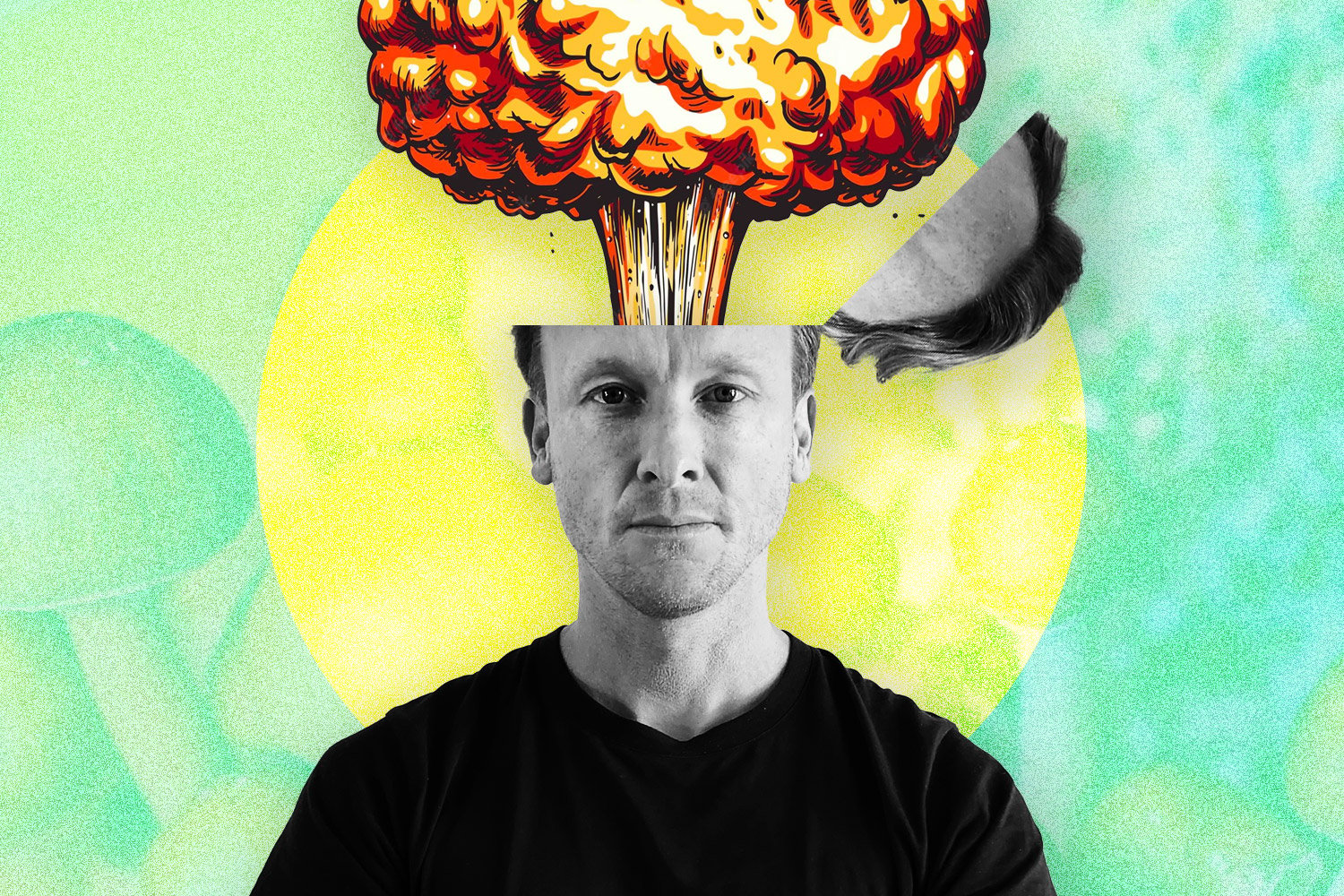SKIMS x The North Face Return With a Bigger, Bolder Winter Collection — Dropping December 9
Dec 6, 2025Psilocybin Therapy Review: I Travelled 16,632 Kilometres To Improve My Mental Health
- Nov 25, 2024
- 0 Comments
768

The psilocybin craze has kicked into overdrive thanks to the likes of Netflix’s How to Change Your Mind and podcasters like Tim Ferriss spruiking its endless benefits. We wanted to see it with our own eyes, so we travelled to Amsterdam, the drug capital of the world, to experience psilocybin therapy or psychedelic insight for ourselves.
Those who know me have long been witness to my many years of anxiety and depression. At 40ish, I feel comfortable enough talking about it and using DMARGE as a platform to share my experiences to help those battling the same demons.
In 2022, I took part in the Hoffman Process: an 8-day retreat in Byron Bay to improve my ability to deal with stress and life. The experience also made me a somewhat more balanced and rational human. “More present and less of a c***”, according to friends, family, and staff.
Regardless of newfound improvements, my anxiety and depression remained. It was neither better nor worse, just always present and requiring daily management. Eat, sleep, gym, meditate, repeat. This is fine… In theory. With work and other life pressures it gets tiring day after day, week after week. Sometimes you just want a cure.
Related Stories
As my need to find a solution ebbed and flowed, my long-suffering partner suggested I look into psilocybin therapy. What’s psilocybin you ask? In short, it’s the key ingredient found in magic mushrooms. Not LSD or acid, which may be your immediate thought, but the main ingredient in those cute little mushrooms you find in fields all over the world.
Psilocybin was first used in the 1960s as an experimental treatment at major universities in America. When the Nixon-era war on drugs started, psilocybin was quickly outlawed and those scientists using it for research were quickly shut down. That was effectively the end of the promising results early research had shown.
Fast forward to the early 2010s and clinical trials began in the US and UK after a renewed interest in the substance. Although conducted in small groups, there were promising signs – especially after the research was backed up by clinical studies paired against anti-depressants.
Leading medical minds like Professor Robin Carhart-Harris and author Michael Pollan were simultaneously conducting their own studies and research, often trialling the substance on themselves to get a better understanding of how these drugs could help the many millions around the world suffering from mental health disorders.
Last month, in a surprising turn of events, the Australian government legalised psilocybin for the treatment of medication-resistant patients suffering from mental health disorders. If Australia – which is traditionally very late to any party – is looking to become one of the first countries in the world to legally prescribe psilocybin as a therapeutic drug, surely these are good signs?
The more I listened and watched, the more I became curious about trying it for myself. Never one to shy away from getting high, psychedelics were never of huge personal interest. My mother would often tell me about a family friend who “never came back” from a bad acid trip. This fairytale was enough to guarantee I never touched psychedelics… Instead, I tried every other drug I could get my hands on. Go figure.
How does psilocybin help with mental health disorders?
While researchers continue to study their therapeutic effects, psilocybin and other psychedelics are believed to facilitate neuroplasticity: a process in which the brain’s wiring is altered, enabling patients to gain new perspectives on long-standing psychiatric issues.
Like all good medicine and treatment, there’s a process that must be followed in order to get the most benefit from the experience. I use the word ‘experience’ to make it sound more professional, but in truth, it’s a trip. You will trip balls, you’ll go where your conscious brain won’t let you and (hopefully) you’ll find some answers.
After a few very short weeks of research, it became clear that Holland was likely the easiest place to begin my psilocybin journey. There were some whispers of people conducting sessions (illegally) in Australia but The Netherlands seemed a more legit option.
There were many facilitators or guides in Holland offering psilocybin trip-sitting and experience. However, I was looking for someone that focused on the mental health side of things.
Perhaps unsurprisingly, there’s almost nowhere currently doing ‘psilocybin therapy’ for mental health disorders outside of trials in hospitals and universities. In fact, everyone we spoke to in Holland refuses to take people on if they’re suffering from any form of severe depression, anxiety, bipolar or schizophrenia. What they are offering is not therapy; they’re offering psychedelic journeys and experiences to change your perspective on this never-ending Ferris wheel we call life.
Psilocybin retreat companies make you fill out a very detailed medical form to ensure you’re of sound mind and body before they take you on as a client. The good news is that those like me, suffering from mild depression and anxiety – meaning never hospitalised – are welcomed with open arms… Provided you don’t dial up the crazy too much in your screening interview.
I jumped on a Zoom with Luc van Poelje from Psychedelic Insights: we shot the breeze for half an hour, he answered all my questions, talked about his experiences with psychedelics then explained how it all worked.
Luc founded Psychedelic Insights to offer qualified trip guides the opportunity to serve clients in an optimised setting and with science-based protocols. The aim: Professional and experienced staff, providing psychological guidance on psychedelic experiences.
One day with Luc’s team will cost you around $3,250 AUD for a private session with two guides (male and female) in a funky hotel near Amsterdam. You can find cheaper guides, but the guides won’t be as experienced and you won’t get the incredibly important integration sessions afterwards.
The alternative is a 3-day experience with someone like Essense, which is also located in The Netherlands. Essence is one of the most well-known psilocybin retreats, however, their practice is in groups rather than private sessions. This was a hard pass for me.
RELATED: $25k For A Pill? Psychedelic Therapy Could Become Australia’s Most Expensive Drug Habit
The Unbound is a bit like Unyoked but closer to the city with running water, electricity and a restaurant. It’s the perfect setting to get your mind altered as it’s free of people and far away from the temptations of Amsterdam. A sacrilegious temptation I knew all too well…
The week before, I met my guides briefly via Zoom as I was crammed into an overpopulated Singapore Airlines lounge. Thankfully, I didn’t give a f*** about tired travellers sitting within earshot overhearing my woes.
Your guides help you define your intention for your trip. For some it may be quitting smoking, for others, it could be healing old wounds. Having good chemistry is important when you’re doing this; you need to trust and feel like your guides have your best interests at heart.
Herman and Karlyn were Dutch, in their 50s or 60s, and kind, compassionate souls. They also looked like they had experienced their fair share of psychedelics in their time. They answered all my questions and helped me share an intention that was realistic. Yes, being realistic about the psilocybin journey is pretty important…
Psilocybin is not a silver bullet, and it probably won’t cure you after one session.
Preparation for my first psychedelic experience was simple: no drugs, no stress, and no booze for the week prior. Don’t eat anything the morning of the trip (an empty stomach enhances the experience). All very simple instructions that paired well with my good intention not to piss $3,250 up the wall.
My guides arrived and we made small talk as they sensed my anxiousness about the experience. I then choose from a couple of packs of vacuumed-packed truffles.
Truffles are legal in The Netherlands but magic mushrooms are not. Why? Truffles are more consistent in dosage and less likely to blow your head off. My two bags (30g) of truffles went into a Parmesan grater and were crushed into a bowl. Hot water was added and we let it sit for 15 minutes. Why this process? Ingesting truffles will most likely make you sick, which is why they make a broth instead.
I drank my potion and plonked myself on the very comfortable bed. With the eye shades down I began to feel the effects of his rather big dose within 10 minutes. A warm feeling washed over me as I sank down into the depths of the bed, quickly followed by intense visuals and… That’s where it gets a bit fuzzy.
What happens on a 6-hour psilocybin trip?
The guides stay with you in the apartment the entire time, coming in regularly to check on you as various questions and emotions pop up. Vocalising what you’re feeling is helpful as you won’t get stuck in mental loops. The guides are there to help you push through those moments.
It’s worth noting you’re not completely ‘out of it’ when you’re high on psilocybin, you’re still very much conscious but with the enhancement of the mushroom. The experience is designed to help you let go of your ego or intellectual self and engage more with your emotional self or “inner child”, as some describe it.
Euphoric music is piped into the room via a $199 JBL boom box. Hans Zimmer’s theme song from Interstellar, Ludovico Ennauldi, the Platoon theme song and 2001: A Space Odyssey’s OST even made the mixtape.
There’s no set amount of time your trip will last. For me, the total experience was 6 hours from start to finish. I laughed, cried, had a bathroom break, chatted to my guides on multiple occasions, went back inward and spent a lot of the time wondering how long I’d been under.
Once the trip had finally worn off and everything began to return to normal, I staggered from my cave and my guides asked questions while I stared blankly at the bowl of frozen mango on the table in front of me.
To be honest, I was glad it was over. It wasn’t a bad experience, but an exhausting one. My brain worked hard for six hours feeling everything, ruminating, questioning, and visiting every corner of my subconscious. I described it as running a mental marathon – roughly a kilometre for every year of my life.
In the following days, I kept a journal nearby as it was helpful for writing down thoughts and experiences from my journey. This would come in handy as I began to integrate during the following weeks and ensure nothing was forgotten.
So you ask, am I immediately cured?
Immediately post-trip, there was a definite lift in my mood. I felt lighter and more content about life. This bliss wasn’t like taking medication, but rather just a natural state of contentment.
Writing this now, the feeling is still present: staying away from stressors, phones and annoying people is recommended for the following few days.
The anxiety, on the other hand, was still present – if anything, perhaps a touch worse due to my unfairly high expectations of the experience. There’s no denying a psychedelic journey can leave you feeling raw and a little beat up, so it wasn’t unsurprising for me to be “feeling the feels” a little more than normal.
There are many deep experiences that have affected change in energy, perception and awareness. Some immediate and others in their own pace. Some drip in, others can be mystical experiences. We can never predict any outcome and also have to prepare people for immense change but also the reality little may happen even. The last is very rare. The first less so.
Luc van Poelje, Founder-CEO Psychedelic Insights
Given everything I had read and watched prior to the experience it had given me very unrealistic expectations. There was an expectation that I would be immediately cured and life would be golden from here on. This is definitely not the case, and won’t be for most people.
Psilocybin is a doorway that, if used correctly, will help you get to parts of your brain that are usually locked away due to your need for control or security. Taking this trip was just a look inside that doorway, a snapshot of what ‘letting go’ can look and feel like.
Now that I know what the experience feels like, I’m looking forward to going again in a few months. They say with a high powerful enough some can experience what’s called ‘ego death’. This complete loss of subjective self-identity is what many hope to achieve to really go deep into themselves.
The next and most important step is integration
Integration is the most important part of psychedelic therapy as it’s where you isolate and address key moments from your experience.
The experiences will be different for everyone, but how you tackle these feelings and issues will be paramount to having some level of success in improving your mental health for the long term. Remember it’s the elastoplasticity or rewiring of your brain that scientists believe is the true benefit of psilocybin. Creating these new neural pathways takes work and time.
It takes your neurology a life time to grow this way, hope we can realise it takes time to rewire differently. I hope with time, even the anti inflammatory properties may help the process. But certainly integration. Observing your own mind and learning the lessons.
Luc van Poelje, Founder-CEO Psychedelic Insights
Integration can last a few months or take as long as three years. Most guides will tell you the integration never ends once you’ve taken your first trip. That’s why having multiple integration sessions planned with your guides in the following weeks will be key to achieving some level of success.
Of the entire psychedelic experience, integration is one area that needs more structure. If so many guides place so much importance on this, then why don’t they put more effort into literature and planning for rewiring your brain?
The future of psilocybin starts now
Based on this one experience, I’m confident that there’s some truth to the hype. A second session is definitely needed within a month or two, depending on how brain-fried you are from your first.
I believe the second session will be where you can go really deep and begin to unlock those doors. Think Christopher Nolan’s film Inception, layers upon layers, dreams in dreams, each going deeper and deeper until you can unlock the most challenging parts of your brain.
There is a distinct feeling that the current ‘companies’ offering these psilocybin experiences are erring on the side of caution and not claiming they will treat mental health disorders. This will change, but it will need more medical intervention, data and processes put into place for people to maximise the potential of the experience.
However, right now, it’s just not there.
Regardless of these initial musings from a first-time tripper, the future is looking bright for alternative treatments… And they can’t come soon enough for so many Australians.
Want to know more? Read about Australia’s move into this space at Mind Medicine Australia.
Publisher: Source link







